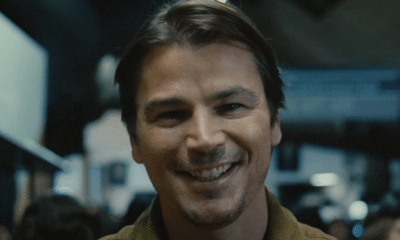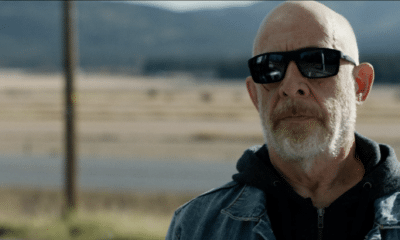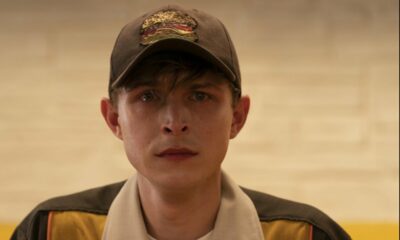James Mangold’s six-time editor, Michael McCusker, on why he approached Le Mans ‘66 as a “four-act movie”

Image: Fox
“A movie is only as long as it feels,” says Michael McCusker, in his editing suite on the Fox lot. “I’ve been into 88-minute movies and they’ve felt like a lifetime. But I can sit down and watch Once Upon A Time In America, which is three hours and 45 minutes, and it’s not long enough.”
McCusker is rapidly approaching the finish line, a “few more tweaks” away from completing a project he is proud to be a part of. And he describes the appeal of working with Mangold simply: “I don’t know any other guys out there who have pretty much worked in every genre. In the time I’ve worked with Jim, I’ve cut a Western, a rom-com, a post-superhero movie and a racing movie. But in one way, they are all the same. Mangold is always looking for story. All of them are really all character-driven movies, and that’s why I got into filmmaking,” he says.
“And this one in particular has been a really great experience,” McCusker adds. “It’s been challenging, too. But when I figured out that really what this is is a four-act movie, that’s when I got the clarity I needed. That’s when I could see what it really is…”
This is a great-looking office, full of interesting movie memorabilia. How long have you been stuck in here, editing this movie?
Ha! [Laughs] Actually, the mix on this one was a little longer than usual – I’d say it was five weeks, on the final stage. This movie is complicated. We’re dealing with a lot of racing stuff, which is a lot of dynamic sound. But we’re also dealing with a lot of characters. It’s a very interesting movie, a very beautiful little character study in the midst of this vast, epic race.
What are the particular challenges on this movie?
There are loads. For instance, we have to make the cars sound correct, historically. No-one ever really thinks about that. They feel it. The sound mix is meant to be felt and not something for you [as an audience] to be aware of. But if it’s off, you know it’s not right. And dealing with multiple characters in cars driving down the race track, when you cut between the cars the sound within each of the cars is different. Each car sounds different, respectively, whether it’s driving past the pits or past the crowd or past whatever. When you’re dealing with that action, every different cut is a different soundscape.
How would you describe your approach on Le Mans ’66?
It’s interesting. I actually call this more of a four-act movie because the Le Mans race itself is about 30 minutes long. Thirty-two minutes, in fact. In and of itself, that’s its own little movie; it has a beginning, a middle and an end. And, in terms of the whole movie, the way I see it – and this is just my interpretation of it, the way I think about the structure of it – is that we’re dealing with a traditional three-act movie all the way through to Daytona [the penultimate race that Christian Bale’s Ken Miles and Matt Damon’s Carroll Shelby tackle before the climactic showdown at Le Mans 1966]. In a traditional movie, the end of that race is the end of the movie. But we are dealing with an actual event and we are setting up Le Mans. We are actually doing something really odd here, which is that we’re giving the audience a significant victory before the final race. And then we have to introduce the audience to Le Mans, to this entirely new milieu.
What does that mean for the audience?
At that race at Le Mans, there is this entire drama that goes on. That 32 minutes in itself has its own three-act structure: Miles starts the race and has some problems, then he overcomes those problems and then he has to overcome his adversaries. Meantime, there is a whole other drama going on about what is happening with Ford in the stands and in the pits, and that’s almost got its own three-act structure too. So, I always look at this movie as a movie of four acts. That was a way for me to stay clear on what we were trying to achieve. In the movie, we talk about Le Mans from the very beginning and then we give them [the audience] the adrenaline-rush of Daytona, which means that when they eventually get to the Le Mans race, they are able to just sit back and lean into the race, are able to understand its nuances and what’s going on other than them just going fast.
There are so many fascinating characters in this movie. How do you make sure no-one gets lost in the edit?
This is something that Jim has been doing as a filmmaker since I’ve worked for him, and I started with him in 2001. I’ve worked on his last eight movies and cut his last six. And what you’re asking is kind of what I was asking on Walk The Line, which we did nearly 15 years ago now. [On that movie] I was asking, ‘What’s the story?’ You know, Johnny Cash had only recently died, so I kept asking, ‘What does this [story] really mean in the grand scheme of things?’ But Jim has always been great at just keeping it focused on the characters. All of his movies really are about one or two characters. That’s what makes them so compelling. So, with regard to this movie, it’s about me keeping my eye on the ball. This movie is about Carroll [Damon] and Ken [Bale]. It’s about those guys. I used to joke and say, ‘If we ever need another title for the movie, we could just call it Carroll And Ken.’ To me, that was the focus, that’s what you’re following through. And you get so immersed in their friendship that you travel through the movie and all the other accoutrements that you could get distracted by – The cars! The gear! The races! The rivalries! – that’s not what it’s about. It’s about these two guys, so when you get into the racing, you’re just feeling what they’re feeling. It’s a little bit of a sleight of hand. If you get that relationship right, all the other stuff is going to come. And all of the other characters around them are so vivid, too. That’s why everyone wants to work with Jim.
How did you go about building the climactic Le Mans sequence?
The Le Mans sequence was written [in the script], but then it was almost written again in pre-vis [the rendering of complex sequences digitally, before shooting]. So, in a weird way, I cut that sequence twice. All the stuff on the track, with Ken in the car, I had cut in pre-vis, and all the stuff in the pits, with Carroll in them, was on storyboards inside the pre-vis. So, we knew where we were placing the drama in the sequence. Making that pre-vis took maybe three months. That’s how you figure out the choreography of the race, and what parts of it, what parts of the track, we were going to dramatise. The challenge on this was to stay true to the pre-vis because the way action movies, particularly racing movies, have changed in the way you shoot them, from even 10/20 years ago, is huge. Back then, they’d have a script and some storyboards, but then they’d get out there [on location] and think about the geography when they got out there. We can now map out the real territory of where we’re going to shoot and know already what the cars can and cannot do in that real space. So, when you get to location, you can shoot what you’ve already seen. You can shoot the movie you dreamed.
What other racing movies did you look at before starting on this?
The [John] Frankenheimer movie [Grand Prix, which starred James Garner, Eva Marie Saint and Yves Montand, in 1966] was a reference early on because what he was doing back then was really pretty spectacular. But, for us, the concept of the race changed over time. The original idea was that we were going to stay in long shots a lot more, but as we got going, we realised we needed the visceral charge of some cutting, as well as that we needed to cut back to the pits for the drama in there as well. Without that, really, we were just going to be showing something that would look like a televised race. When Frankenheimer shot that movie, that was a relatively new thing on TV. But, by now, people know what a race looks like! So, what we’re doing, what we’re bringing to this, is bringing in that emotional connection, that emotional experience – to give you that thrill that you’re not going to get from watching a race in any other way.”
How did you capture the speed of the racing on film?
Look, you cross your fingers that when the real footage comes in [from the set] it’s going to look as good as you dreamed it, and we were lucky because it did. That to me was what this was all about. I was always a racing fan as a kid, and what we all wanted to recapture was that sheer thrill of it that you felt the very first time you saw it. Jim was chasing the same thing. But that only works if you do it with stakes, with characters, with drama. That’s when it has the impact. When you watch the race in this movie, Ken is always facing obstacles. It’s like soul-surfing, in a way. Miles is soul-racing in this, he is on a spiritual journey and you [as the audience] are so on board with that. You know, there is a moment in the race where Christian [as Miles] has a reaction on his face to something that has happened, and it just gives me chills. It really does. I must have watched that part 80 times now and it gets me every single time. This guy who has been keeping it packed in this whole movie has this private moment in the car and it is just extraordinary. People will talk about the racing in this movie, and that’s great. They’ll talk about the editing, and that’s nice too. But what it comes down to is that you’re rooting for this guy, rooting for him to get through all of these obstacles. Everything that is set up in the movie is paid off in that race and none of it feels false.
Is this the most difficult movie you’ve ever worked on?
There’s an old saying in the editing world: ‘Sometimes the hardest movies to work on are the ones that don’t work.’ The ones you’re just trying to get to work and you don’t know if you can. And I’ve worked on some of those. On this movie, the problem was actually more the other way around, that we knew deep down that we were onto something good. Jim and I are always trying to be as objective about the movie as possible. It’s a tough thing. You’re dedicated to it and you want to love it, but you can’t love all of it or you can’t cut any of it! In this movie, there was a lot of work and a lot of hours, but we always knew where we were going…
LE MANS ’66 is OUT NOW on Digital Download, 4k Ultra HD™, Blu-ray™, DVD & VOD.

Latest Posts
-


Film Trailers
/ 6 hours agoM. Night Shyamalan’s ‘Trap’ trailer lands
Anew experience in the world of M. Night Shyamalan.
By Paul Heath -


Film News
/ 21 hours agoFirst ‘Transformers One’ teaser trailer debuts IN SPACE!
The animated feature film is heading to cinemas this September.
By Paul Heath -


Film Reviews
/ 21 hours ago‘Abigail’ review: Dirs. Matt Bettinelli-Olpin & Tyler Gillett (2024)
Matt Bettinelli-Olpin and Tyler Gillett direct this new horror/ heist hybrid.
By Awais Irfan -


Film Trailers
/ 22 hours agoNew trailer for J.K. Simmons-led ‘You Can’t Run Forever’
A trailer has dropped for You Can’t Run Forever, a new thriller led by...
By Paul Heath















